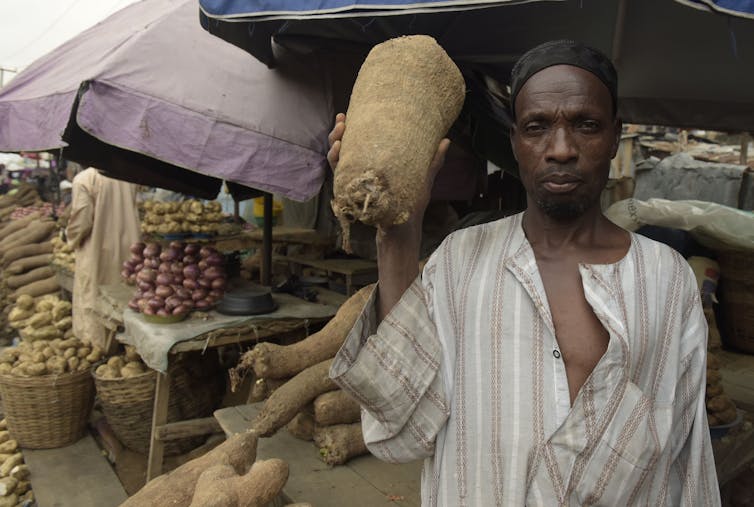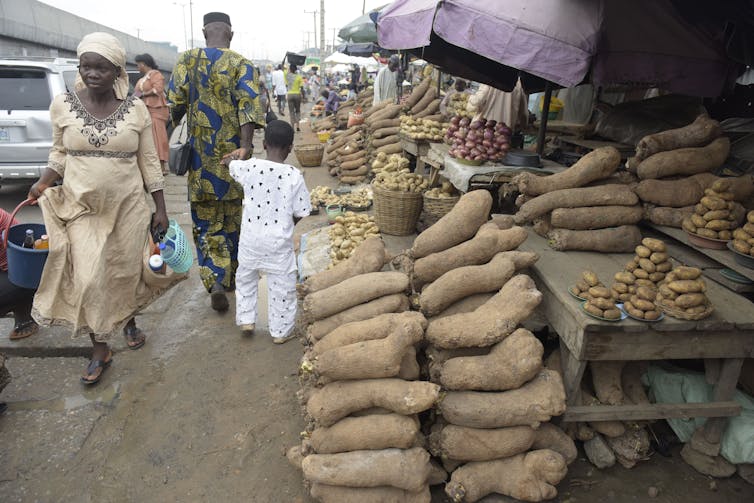
Bolanle Akinwande, Ladoke Akintola University of Technology, Ogbomoso
Nigeria accounts for 60% of the world’s [yam output] and 74% of the total production in West Africa. Grown as a staple food, the tuber of the yam plant is its economically important part. The yam tuber, as in other tuber crops, is essentially a starchy or carbohydrate food and its principal nutritional function is the supply of calories.
The challenge, however, is that the onset of maturity in yam is not well understood and the date of harvest often bears no relationship to the functions and activities of the tuber. As a result farmers aren’t able to accurately determine the best time to harvest the crop.
In the course of my research, I have found a scientific process that would enable yam farmers to determine the earliest possible time at which harvesting could be done. I found that the most advantageous time to harvest is when the starch content of the leaf is at minimum levels. It’s as this point that the lower leaves start to turn yellow. I established that this happened before the whole leaves started to decompose, some six months after planting had been done in the rainy season.
Harvesting yams at this point would have two major benefits. It would help improve the food and storage quality of the yam. It would also ensure that the farmer could use the same plot of land for planting another crop, especially vegetables, before the end of the rainy season to generate more income. This would benefit subsistence farmers enormously.
The process
My research involved planting whole seed tubers of various sizes (100 g – 300 g) from five local varieties and 15 genotypes of white yam at the beginning of the rainy season. I conducted my research in 2003 and 2004 but the findings remain relevant.
Harvesting was done at monthly intervals four months after planting was done and when the vines began to emerge. Harvesting continued until the point at which the foliage started to decompose.
Within this period the dry matter, sugar and starch contents of both the leaves and yam tubers were measured. The aim was to derive an indication of the best time to harvest the tuber.
Dry matter: In the leaves dry matter content increased steadily from four months till six months after planting when the lower leaves started to turn yellow. In the tuber dry matter content increased steadily as they aged until all the leaves decomposed. I deduced from this that harvesting was best done when the spike in dry matter content of leaves was noticed – that is when they started to turn yellow.
Sugar content: In the leaves sugar content went up and down as the plants grew, but dropped drastically by the time all the leaves had decomposed. In the tuber, the sugar content reduced as the tuber grew, but then increased sharply by the time the leaves decomposed. My conclusion from this was that it is better to harvest the tubers when there is a sharp decrease in sugar content of leaves – and increase in the sugar content of the tuber.
Starch content: The accumulation of starch in the tuber reached its peak when accumulation of starch in the leaves started which made them turn yellow.
Since yam tuber is essentially a starchy food and its principal nutritional function is the supply of calories, it is most appropriate to harvest it at this time, especially with no appreciable increase in tuber yield any longer.
I concluded from my research that the starch content of leaves was the determining factor for when the tuber had reached maturity. The yam tuber was fully matured when minimum starch content was obtained in the leaves. These low levels of starch content were marked by the yellowing of the lower leaves of the plant. This provided a clear indication of the earliest possible time to harvest the yam.

The problem
Before our findings, farmers used subjective ways of determining when to harvest their yams. This often adversely affected the quality and yield of their farms. The most common measures farmers used were observing their yams, as well as calculating when to harvest based on the date of planting.
These rather crude indices had been developed over the years. They were based on observations of the ageing process of parts of the yam, percentage of the tuber length that was whitish at harvest or those that had a bitter taste after cooking.
Using these methods meant that more emphasis was placed on an individual element, such as the taste after cooking. But this amounted to what I call a “maturity of convenience”, rather than “harvest maturity.” And it’s generally a compromise between social requirements and those of the plant’s biology.
The result is that yam tubers are harvested either too early, or too late.
By using the simple technique of harvesting when the lower leaves begin to turn to yellow, farmers can harvest before the entire leaves decompose and be sure of matured yams being harvested. It will also mean that farmers will be able to use the fields to plant for income-earning crops such as vegetables before the end of the farming season. This could translate into improved livelihoods for farmers.![]()
Bolanle Akinwande, Professor of Food Science, Ladoke Akintola University of Technology, Ogbomoso
This article is republished from The Conversation under a Creative Commons license. Read the original article.

